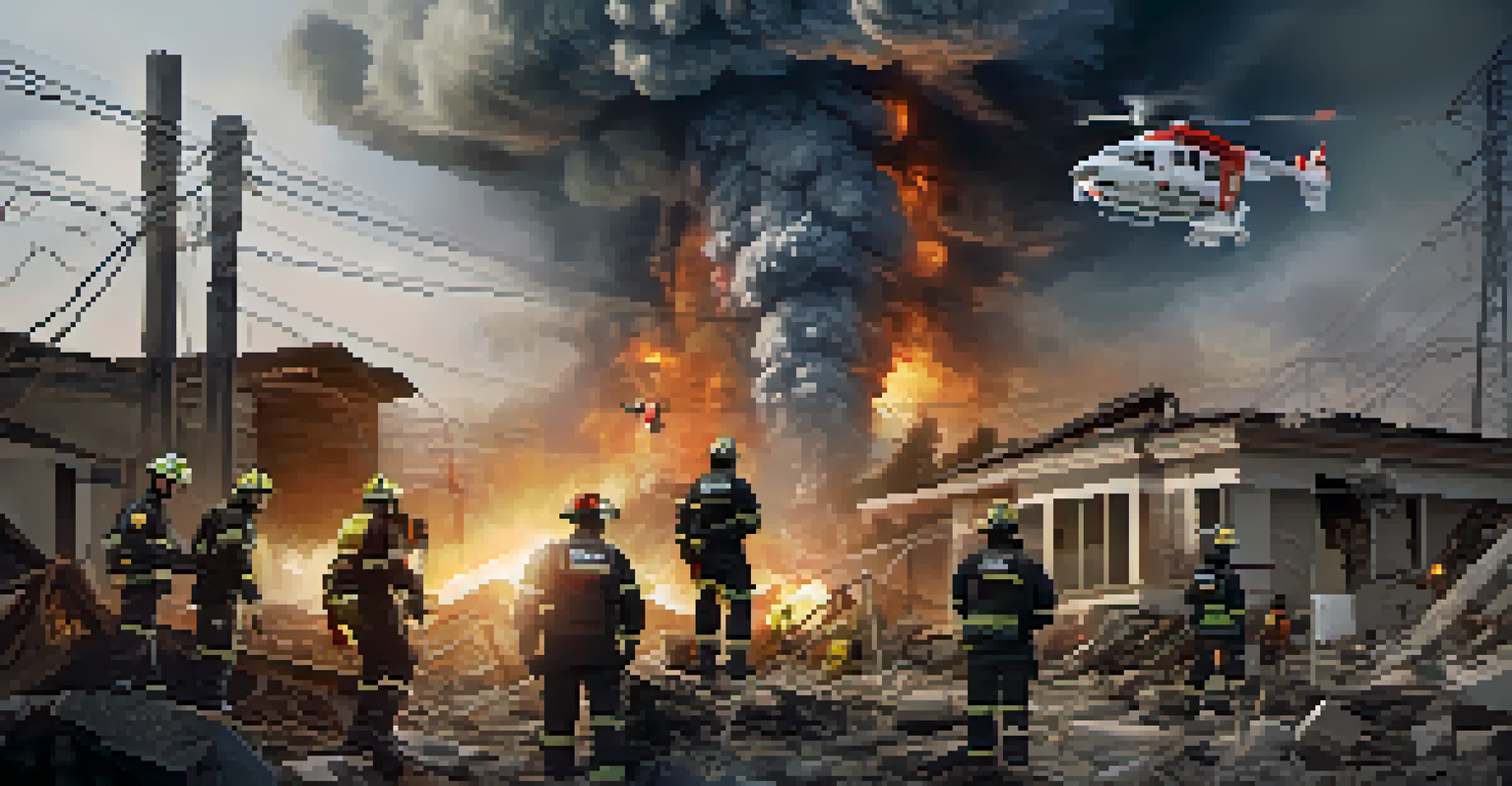Public Safety: Leveraging IoT for Emergency Response

Understanding IoT and Its Role in Public Safety
The Internet of Things (IoT) refers to the network of connected devices that communicate and share data. In the realm of public safety, IoT devices can be anything from smart sensors to drones. These technologies enable real-time data collection and analysis, which is crucial during emergencies.
The Internet of Things is not a concept; it is a way of life. It connects everything and everyone, enabling us to respond faster and smarter.
For example, smart cameras can provide live feeds to emergency responders, allowing them to assess situations before arriving on-site. This capability not only improves response times but also enhances situational awareness. Thus, understanding IoT is essential for grasping its impact on public safety.
Moreover, the integration of IoT into emergency response systems can lead to better resource allocation. By analyzing data trends, authorities can predict potential emergencies and prepare accordingly, ultimately saving lives.
Real-Time Data Collection for Faster Response
One of the standout features of IoT is its ability to collect data in real-time. During an emergency, every second counts, and being able to access immediate information can make a significant difference. IoT devices, such as environmental sensors, can monitor conditions like air quality or radiation levels, alerting responders to hazards.

Take, for instance, a natural disaster scenario where IoT sensors can detect seismic activity. This data can trigger early warning systems, allowing communities to evacuate before a devastating earthquake strikes. Such proactive measures are vital in mitigating risks associated with emergencies.
IoT Enhances Emergency Response
IoT devices facilitate real-time data collection and improved communication, enabling faster and more effective emergency response.
Additionally, real-time data enables first responders to collaborate more effectively. With access to shared information, agencies can coordinate their efforts, ensuring that help reaches those in need as quickly as possible.
Predictive Analytics: Anticipating Emergencies
Predictive analytics involves using historical data and trends to forecast future events. In public safety, this can be a game changer. By leveraging IoT data, emergency services can identify patterns that may indicate an impending crisis, such as an uptick in fire alarms or weather patterns signaling severe storms.
In the face of emergencies, real-time data collection can be the difference between chaos and order.
For example, analyzing data from connected sensors in a city can help officials anticipate where wildfires are likely to spread. This foresight allows for preemptive measures, such as controlled burns or evacuations, ultimately reducing the impact of disasters.
Furthermore, predictive analytics fosters community resilience. When citizens are educated about potential risks and prepared for emergencies, the overall safety of the community improves.
Enhanced Communication During Crises
Effective communication is vital during emergencies, and IoT can streamline this process. By utilizing connected devices, emergency services can share critical information with the public and each other in real-time. This ensures that everyone is on the same page and can respond appropriately.
For instance, IoT-enabled alert systems can send out notifications to residents about impending dangers, such as floods or chemical spills. This immediate communication can save lives by allowing people to take action quickly.
Predictive Analytics for Safety
By analyzing IoT data, emergency services can anticipate emergencies and implement preemptive measures to mitigate risks.
Moreover, during a crisis, IoT devices can facilitate communication between different agencies. By sharing information seamlessly, responders can work together more efficiently, ultimately improving the overall effectiveness of the emergency response.
Smart Infrastructure: A Foundation for Safety
Smart infrastructure refers to the integration of IoT technology into cities' physical structures, such as roads, bridges, and buildings. This innovation plays a crucial role in enhancing public safety during emergencies. For example, smart traffic lights can be programmed to clear paths for emergency vehicles, minimizing delays.
Additionally, connected streetlights can serve as communication hubs, providing updates on road conditions or hazards. This information can be invaluable for both responders and the public, ensuring everyone remains informed.
As cities continue to evolve, investing in smart infrastructure will be essential. By creating environments equipped with IoT technology, communities can significantly improve their emergency preparedness.
Challenges in Implementing IoT for Public Safety
While the benefits of IoT in public safety are clear, there are challenges to consider. One major hurdle is ensuring data privacy and security. With connected devices collecting sensitive information, it is crucial to implement strong security measures to protect this data from unauthorized access.
Moreover, the integration of various IoT systems can be complex. Different agencies may use different technologies, making it challenging to share information seamlessly. Establishing standardized protocols can help streamline this process and ensure effective communication.
Challenges of IoT Implementation
Despite its benefits, the integration of IoT in public safety faces challenges such as data security, system compatibility, and funding.
Finally, there’s the issue of funding. Implementing IoT solutions requires significant investment, and securing the necessary resources can be difficult. However, the potential for improved public safety makes this investment worthwhile.
The Future of IoT in Emergency Response
As technology continues to advance, the role of IoT in public safety will only grow. Future innovations may include more sophisticated sensors, AI-driven analytics, and even autonomous vehicles for emergency response. These developments promise to enhance the effectiveness of emergency services even further.
Moreover, community engagement will play a crucial role in this evolution. Educating the public about IoT technologies can empower citizens to participate actively in safety initiatives and emergency preparedness.

In conclusion, the future looks bright for IoT in emergency response. By harnessing the power of connected devices, we can create safer communities and respond to emergencies more effectively.